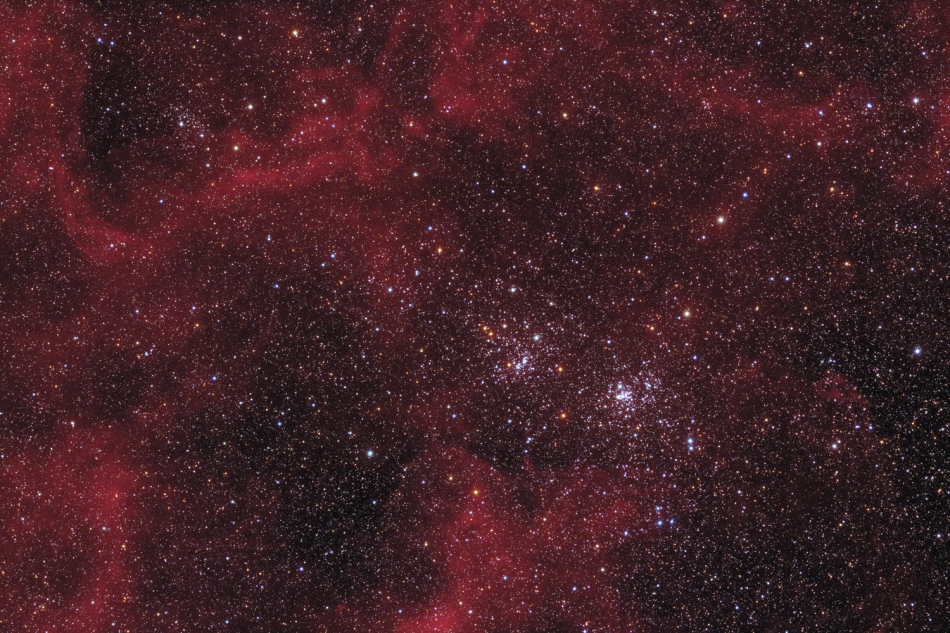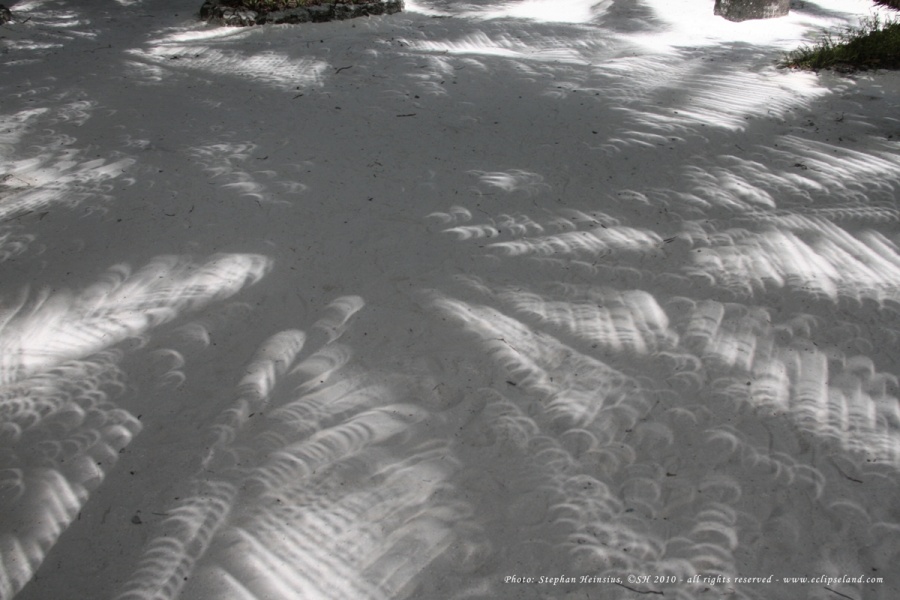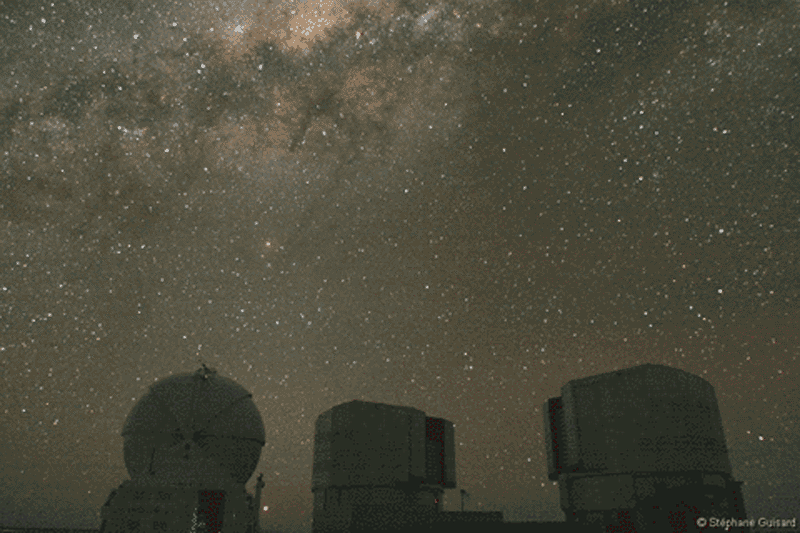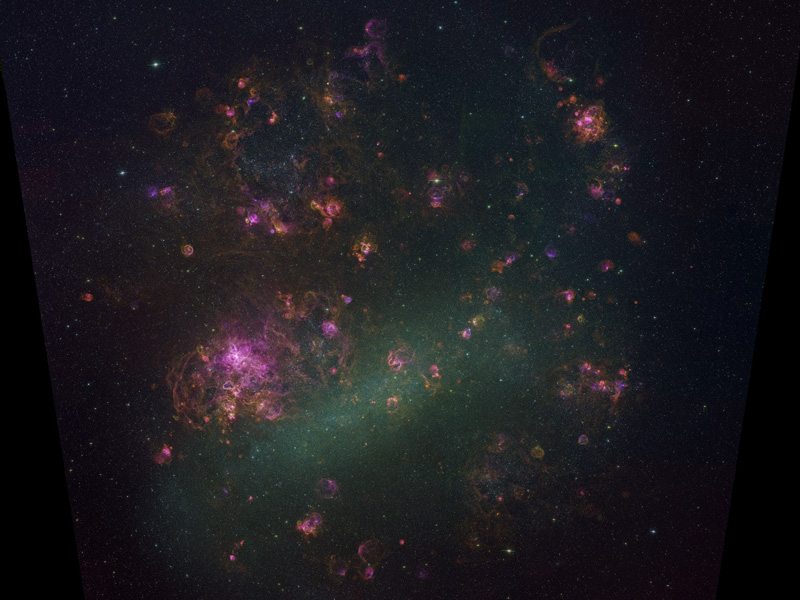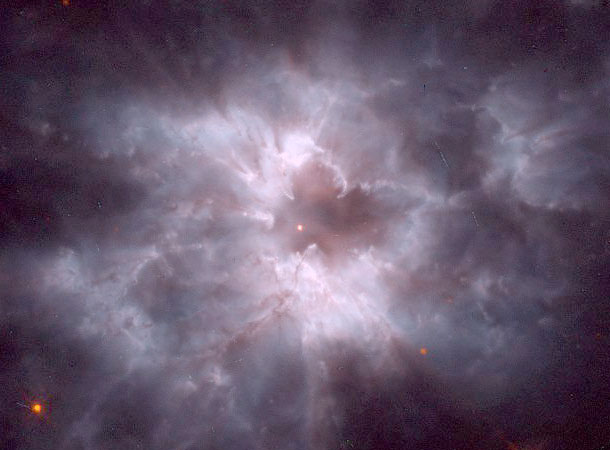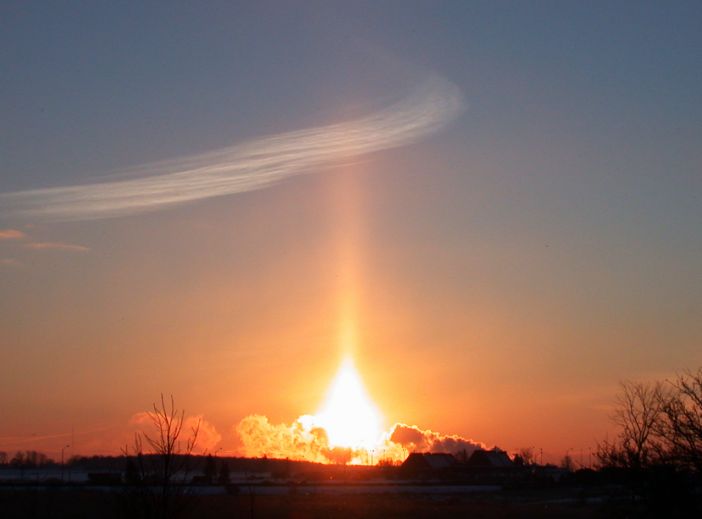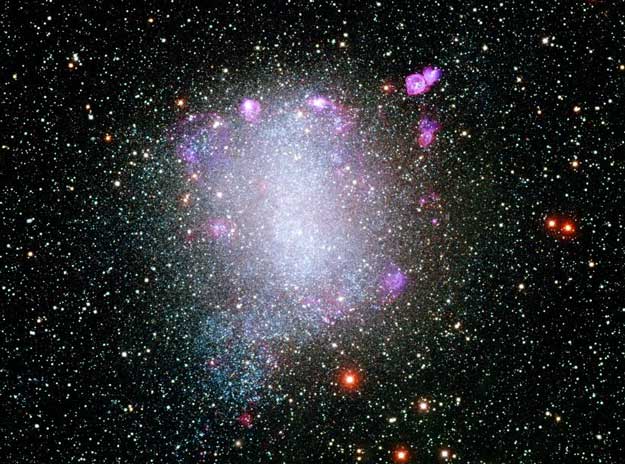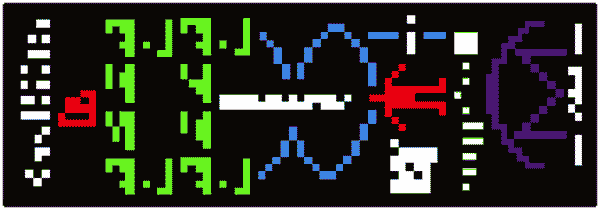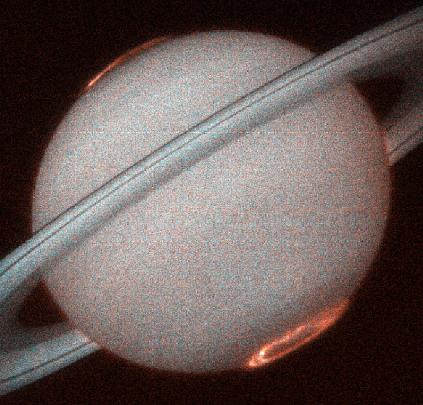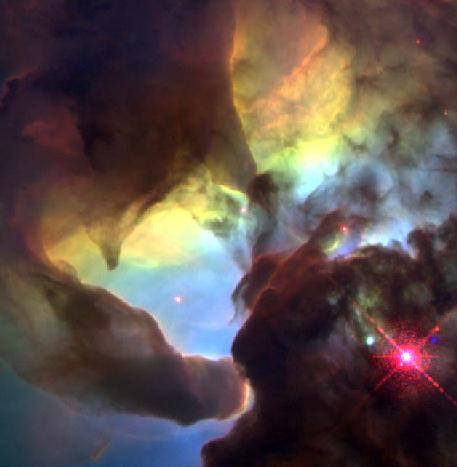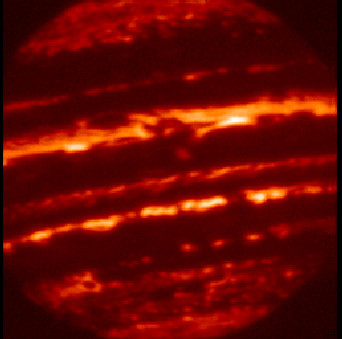| << Previous | Index | Next >> |
2015 Some prefer windows, and these are the best available on board the International Space Station. Taken on January 4, this snapshot from inside the station's large, seven-window Cupola module also shows off a workstation for controlling Canadarm2. Used to grapple visiting cargo vehicles and assist astronauts during spacewalks, the robotic arm is just outside the window at the right. The Cupola itself is attached to the Earth-facing or nadir port of the station's Tranquility module, offering dynamic panoramas of our fair planet. Seen from the station's 90 minute long, 400 kilometer high orbit, Earth's bright limb is in view above center.
2014 This lovely starfield spans some seven full moons (about 3.5 degrees) across the heroic northern constellation of Perseus. Just right of center it holds the famous pair of open or galactic star clusters, h and Chi Persei. Also cataloged as NGC 869 (right) and NGC 884, both clusters are about 7,000 light-years away and contain stars much younger and hotter than the Sun. Separated by only a few hundred light-years, the clusters are both 13 million years young based on the ages of their individual stars, evidence that they were likely a product of the same star-forming region. Always a rewarding sight in binoculars, the Double Cluster is even visible to the unaided eye from dark locations. Not seen in binoculars though, and not often depicted in telescopic images of the region are faint clouds of reddish ionized hydrogen gas found throughout this remarkable cosmic skyscape. A color composite, the image includes narrowband data to enhance emission from the hydrogen clouds. Visible toward the upper left of the wide field of view is another, smaller open star cluster, NGC 957, also of similar age, distance, and possibly related to the more famous Double Cluster in Perseus.
2013
2012
[imghover6=http://apod.nasa.gov/apod/image/1201/or ... o_1024.jpg]http://apod.nasa.gov/apod/image/1201/or ... d_1024.jpg[/imghover6]Image Credit & Copyright: Juan Carlos Casado (TWAN)
2011
Click to play embedded YouTube video.
Credit: J. Derr (WWCP)
2010 Eclipses are everywhere in this shady scene. The picture was taken on the Indian Ocean atoll island of Ellaidhoo, Maldives, on January 15, during the longest annular solar eclipse for the next 1,000 years. Tall palm trees provided the shade. Their many crossed leaves created gaps that acted like pinhole cameras, scattering recognizable eclipse images across the white sands of a tropical garden near the beach. From this idyllic location near the centerline of the Moon's shadow track, the ring of fire or annular phase of the eclipse lasted about 10 minutes and 55 seconds.
2009 Of three objects prominent in this thoughtful telescopic image, a view toward the stealthy constellation Lynx, two (the spiky ones) are nearby stars. The third is the remote globular star cluster NGC 2419, at distance of nearly 300,000 light-years. NGC 2419 is sometimes called "the Intergalactic Wanderer", an appropriate title considering that the distance to the Milky Way's satellite galaxy, the Large Magellanic Cloud, is only about 160,000 light-years. Roughly similar to other large globular star clusters like Omega Centauri, NGC 2419 is itself intrinsically bright, but appears faint because it is so far away. NGC 2419 may really have an extragalactic origin as, for example, the remains of a small galaxy captured and disrupted by the Milky Way. But its extreme distance makes it difficult to study and compare its properties with other globular clusters that roam the halo of our Milky Way galaxy.
2008 Astronaut self-portraits can be particularly interesting. Visible in the above picture, working in from the outer borders, are the edges of the reflecting helmet of a space suit, modules of the International Space Station (ISS), the Earth, the arms of Expedition 15 astronaut Clay Anderson, and the digital camera used to snap the image. This picture was taken during the shuttle orbiter Endeavour's mission to expand the space station last August. The large curvature of the Earth appearing in the visor reflection is not the true curvature of our spherical Earth, but rather an artifact of the curve of the space helmet. Earth's horizon appears only slightly curved when viewed from the height of the ISS -- approximately 400 kilometers. The next space shuttle mission to the space station is currently expected to take place next month and includes the installation of the scientific Columbus Laboratory.
2007 It's not the sky that's falling. More accurately, the Earth is rising. The Earth's rotation gives a continually changing view to all Earth observers, including those measuring the universe at the Paranal Observatory. The observatory's four, massive 8.2 meter telescope units are situated on top of the 2,600 meter high mountain, Cerro Paranal, in the dry Atacama Desert in northern Chile. The individual unit telescopes can be used separately or in combination. Their names, Antu, Kueyen, Melipal, and Yepun, are taken from the Mapuche language. Fittingly they translate to Sun, Moon, Evening Star, and Southern Cross. Together they are fittingly known as the European Southern Observatory's Very Large Telescope. A higher time resolution version of the above movie is available here.
2006 What goes on inside of a galaxy? To help find out, astronomers from the Magellanic Cloud Emission Line Survey team imaged our neighboring LMC galaxy in spectacular detail and highlighted very specific colors of light emitted by glowing gas. The above mosaic of over 1,500 images of the Large Magellanic Cloud (LMC) is the result -- clicking on the image will bring up an image with much greater detail. The colors highlighted on the mosaic are light emitted by hydrogen (red), oxygen (green), and sulfur (yellow), while light from individual stars has been subtracted. The mosaic shows what a busy and violent place the inside of the LMC really is. Visible in the above image are many small planetary nebulas pushed out by low mass stars, large emission nebula of ambient interstellar gas set aglow by massive stars, and huge gaseous supernova remnants cast off by massive stars exploding. The extended connected filaments are mostly connected supernova remnants. The LMC, a familiar sight to an unaided eye in the southern hemisphere, spans about 15,000 light years and lies only about 180,000 light years distant.
2005 Like a butterfly, a white dwarf star begins its life by casting off a cocoon that enclosed its former self. In this analogy, however, the Sun would be a caterpillar and the ejected shell of gas would become the prettiest of all! The above cocoon, the planetary nebula designated NGC 2440, contains one of the hottest white dwarf stars known. The white dwarf can be seen as the bright dot near the photo's center. Our Sun will eventually become a "white dwarf butterfly", but not for another 5 billion years. The above false color image was post-processed by Forrest Hamilton.
2004 NGC 4631 is a big beautiful spiral galaxy seen edge-on only 25 million light-years away towards the small northern constellation Canes Venatici. This galaxy's slightly distorted wedge shape suggests to some a cosmic herring and to others the popular moniker of The Whale Galaxy. Either way, it is similar in size to our own Milky Way. In this gorgeous color image, the Whale's dark interstellar dust clouds, young bright blue star clusters, and purplish star forming regions are easy to spot. A companion galaxy, the small elliptical NGC 4627 appears above the Whale Galaxy. Out of view off the lower left corner of the picture lies another distorted galaxy, the hockey stick-shaped NGC 4656. The distortions and mingling trails of gas and dust detected at other wavelengths suggest that all three galaxies have had close encounters with each other in their past. The Whale Galaxy is also known to have spouted a halo of hot gas glowing in x-rays.
2003 On January 16, NASA's space shuttle Columbia roared into blue morning skies above Kennedy Space Center on STS-107, the first shuttle mission of 2003. But this is not a picture of that launch! It was taken on the morning of January 16 though, at sunrise, looking eastward toward Lake Ontario from just outside of Caledon, Ontario, Canada. In the picture a sun pillar, sunlight reflecting from ice crystals gently falling through the cold air, seems to shoot above the fiery Sun still low on the horizon. By chance, fog and clouds forming over the relatively warm lake look like billowing smoke from a rocket's exhaust plume and complete the launch illusion. Amateur photographer Lauri Kangas stopped on his way to work to record the eye-catching sun pillar launch.
2002 Nearby galaxy NGC 6822 is irregular in several ways. First, the galaxy's star distribution merits a formal classification of dwarf irregular, and from our vantage-point the small galaxy appears nearly rectangular. What strikes astronomers as more peculiar, however, is NGC 6822's unusually high abundance of HII regions, locales of ionized hydrogen that surround young stars. Large HII regions, also known as emission nebulas, are visible surrounding the small galaxy, particularly toward the upper right. Toward the lower left are bright stars that are loosely grouped into an arm. Pictured above, NGC 6822, also known as Barnard's Galaxy, is located only about 1.5 million light years away and so is a member of our Local Group of Galaxies. The galaxy, home to famous nebulas including Hubble V, is visible with a small telescope toward the constellation of Sagittarius.
2001 One of the largest spheres in our Galaxy is giving valuable clues about the chemical composition of stars by its very shape. Planetary nebula Abell 39, now six light-years across, was once a sun-like star's outer atmosphere expelled thousands of years ago. The nearly perfect spherical nature of Abell 39 allows astronomers to accurately estimate how much relative material is actually absorbing and emitting light. Observations indicate that Abell 39 contains only about half of the oxygen found in the Sun, an intriguing but not surprising confirmation of the chemical differences between stars. The reason why the central star is slightly off center by 0.1 light-years is currently unknown. Abell 39 lies about 7000 light years away, although several galaxies millions of light years away can be seen through and around the nebula.
2000 What are these Earthlings trying to tell us? The above message was broadcast from Earth towards the globular star cluster M13 in 1974. During the dedication of the Arecibo Observatory - still the largest radio telescope in the world - a string of 1's and 0's representing the above diagram was sent. This attempt at extraterrestrial communication was mostly ceremonial - humanity regularly broadcasts radio and television signals out into space accidentally. Even were this message received, M13 is so far away we would have to wait almost 50,000 years to hear an answer. The above message gives a few simple facts about humanity and its knowledge: from left to right are numbers from one to ten, atoms including hydrogen and carbon, some interesting molecules, DNA, a human with description, basics of our Solar System, and basics of the sending telescope. Several searches for extraterrestrial intelligence are currently underway, including Project Phoenix and one where you can use your own home computer.
1999 Girdling the second largest planet in the Solar System, Saturn's Rings are one of the most spectacular sights for earthbound telescopes. This image from the orbiting Hubble Space Telescope's STIS instrument, offers a striking view of another kind of ring around Saturn - pole encircling rings of ultraviolet aurora. Towering more than 1,000 miles above the cloud tops, these Saturnian auroral displays are analogous to Earth's. Energetic charged particles in the Solar Wind are funneled by the planet's magnetic field into polar regions where they interact with atmospheric gases. Following the ebb and flow of Saturn's aurora, researchers can remotely explore the planet's atmosphere and magnetic field. In this false color image, the dramatic red aurora identify emission from atomic hydrogen, while the more concentrated white areas are due to hydrogen molecules. In 2004, NASA plans to begin making close-up studies of the Saturnian system with the Cassini Spacecraft.
1998
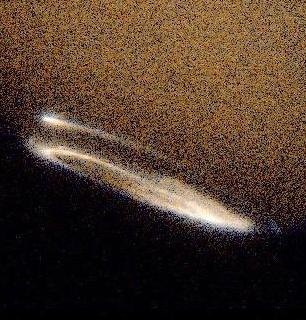
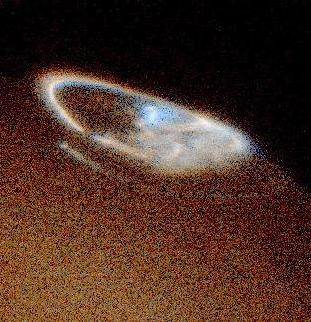
Credit: J. Clarke (Univ. Michigan), NASA
1997 The awesome spectacle of starbirth produces extreme stellar winds and intense energetic starlight -- bombarding dusty molecular clouds inside the Lagoon Nebula (M8). At least two long funnel shaped clouds, each roughly half a light-year long, have apparently been formed by this activity. They extend from the upper left of this close-up of the bright area of the Lagoon known as 'the Hour Glass'. Are these interstellar funnel clouds actually swirling, twisting analogs to Earthly tornados? It's possible. As energy from nearby young hot stars, like the one at lower right, pours into the cool dust and gas, large temperature differences in adjoining regions can be created generating shearing winds. Confirmation of tornado-like motions within the Lagoon's stellar nursery could come from new instruments scheduled to be installed on the Hubble Space Telescope (HST) during February's servicing mission. This picture is a recently reprocessed HST image made in 1995 as researchers explored this nearby (5,000 light-year distant) starforming region which lies in the direction of Sagittarius.
1996 This near-infrared image of Jupiter was made using instrumentation at NASA's Infrared Telescope Facility, located on the summit of Mauna Kea, Hawaii, in support of the Galileo mission to Jupiter. The brightest spots indicated by the false red shading are relatively clear areas and represent glimpses beneath the outer layer of Jupiter's obscuring cloud tops. On December 7, 1995 a probe from the Galileo spacecraft parachuted through these clouds for 57 minutes before melting, all the while providing the first direct sampling of the conditions there. In a recent press release of the probe's findings scientists announced some surprising results. Discoveries based on probe data included a new radiation belt 31,000 miles above the cloud tops, relatively constant high velocity winds (up to 330 mph), no obvious water clouds, low abundances of Helium and Neon, lightning occurring only 1/10th as much as on Earth, and unexpectedly high temperatures. The Galileo orbiter continues its two-year mission to explore the Jovian system.
| << Previous | Index | Next >> |

